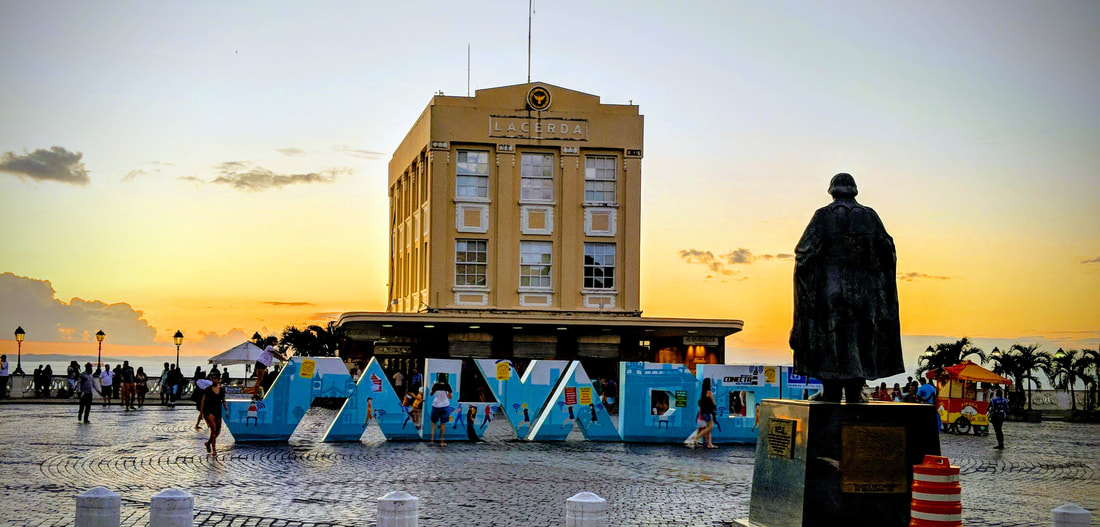|
By Julia Krystofiak and Grace Terlinden Class inequality is very apparent throughout Brazil and was especially prevalent in the city of Salvador, Bahia. One of the most significant manifestations of this class inequality can be observed in housing disparities between the interior and the periphery of the city. The interior of the city houses most upper class and upper middle-class people in Bahia, while the periphery, or suburbs, is home to many lower middle-class and lower-class people. The dominant class status in these distinct areas is represented by available housing, the presence of retail and restaurants, and personal transportation (cars, motorcycles, etc.) among other things. Our host families lived in the interior of the city in upper middle-class neighborhoods called Graça and Vitoria. The interior of the city is abundant with polished high-rise apartment buildings, shopping centers, drug stores, and restaurants. Most people in the interior of Salvador commuted through the city in their newer, personal cars or had family drivers. Their apartment buildings had doormen and maids that watched over and maintained their living spaces. Many of these buildings also had special “service” doors and elevators, representing separation by class even within the interior of the city. Favelas are large communities often located on the outer parts of larger cities. Our tour guide, Fredi, described the favelas as unregulated communities in which the residents build their own residences and aren’t required to pay rent or any tax on their property, because they essentially have no legal right to the land. The enormous population of the favelas is what keeps the government from forcibly removing the residents but engages in discriminatory practices that keep the residents of favelas from gaining equal opportunities. The two physical distinctions of favelas that Fredi pointed out are: they are located in the outskirts of the city and far away from the “inner city” and favelas expand horizontally while the inner-city expands vertically. The favela communities are typically viewed as dangerous, and the Brazilian police have tried to “pacify” these communities by increasing patrol in the neighborhoods and using other proactive policing strategies (Mitchell-Walthour 2017, 220). Policies such as these claim to be for the public good, but they are proven to be violent themselves, and have resulted in the mass killings of innocent residents (Mitchell-Walthour 2017, 220). Bolsonaro has exacerbated these tensions between racial and class groups, through fueling Brazilians fear of crime (Chagas-Bastos 2019). Recent research has supported the claim that Bolsonaro's “environment of fear” utilized in his campaign, has increased violence between social groups (Chagas-Bastos 2019). Bolsonaro’s position on race and class in general is important to understand the future of favelas and inequality as his impact lasts beyond his time in office. It is important to note that these class disparities are inextricably connected to race and racism (Mitchell-Walthour 2017). Discussions about issues concerning class in Brazil often exclude the role that race plays in class disparities, likely due to the myth of mestiçagem (Mitchell-Walthour 2017, Marshall 2017). Ideas about Brazil being a racial democracy suggest that societal disparities are more related to class than race because the racial spectrum in Brazil produces a society in which racism “cannot exist” (Marshall 2017). In contrast to Freyre’s myth of mestiçagem, class status, in addition to physical features and phenotype, is used in Brazil to classify people into different racial categories (Mitchell-Walthour 2017). Elites engage with the narrative surrounding inequality by claiming that policies that help to decrease inequalities exist only because of prejudice against elites (Carrillo 2020). This practice of victimizing themselves has subsequently made light of the real racial and economic inequalities that exist and persist because of the elites’ practices (Carrillo 2020). References: Eakin, Marshall C. 2017. " The Beautiful Game: Performing the Freyrean Vision," in Becoming Brazilians: Race and National Identity in Twentieth-Century Brazil. Cambridge: Cambridge University Press. https://doi.org/10.1017/9781316800058. Fabrício H. Chagas-Bastos. "Political Realignment in Brazil: Jair Bolsonaro and the Right Turn". Revista de Estudios Sociales, no. 69 (2019): 92-100. https://doi.org/10.7440/res69.2019.08 Ian, Carrillo. “Racialized Organizations and Color-Blind Racial Ideology in Brazil,” Sociology of Race and Ethnicity 7 (1): 56-70. doi:10.1177/2332649220943223. Mitchell-Walthour, Gladys L. 2017. The Politics of Blackness: Racial Identity and Political Behavior in Contemporary Brazil.”Cambridge: Cambridge University Press. https://doi.org/10.1017/9781316888742.001. Julia Krystofiak is going into her senior year at the College of Saint Benedict and Saint John's University. She is pursuing a degree in political science and data analytics and hopes to attend graduate school following her undergraduate studies. She is originally from Mounds View, MN. Julia enjoys learning about gendered power structures, international relations, and civil conflict. She has been involved in multiple research projects focusing on gendered and populist rhetoric, which is extremely relevant to Brazil under Bolsonaro. She looks forward to better understanding human impact on the climate and natural world in the context of Brazil! Grace Terlinden is a rising senior at the College of Saint Benedict/Saint John’s University, pursing degrees in English and Political Science. She is originally from Big Lake, Minnesota.
She enjoys learning about international relations through her involvement in Model United Nations. She is very excited to learn more about Brazilian politics and life in Brazil while studying abroad.
0 Comments
Leave a Reply. |
Archives
June 2024
Categories
All
|


 RSS Feed
RSS Feed
